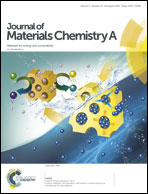Bioinspired sea-sponge nanostructure design of Ni/Ni(HCO3)2-on-C for a supercapacitor with a superior anti-fading capacity†
Abstract
Rational design of novel structures plays a key role in achieving high specific capacities and fast charge rates with a long cycling life for battery-type electrodes of supercapacitors. To tackle capacity fading issues of battery-type electrode materials for supercapacitors, a new approach is proposed to form a bioinspired sea-sponge nanostructure of Ni/Ni(HCO3)2-on-C, synthesized through modifying triangle nanoflakes of Ni(HCO3)2 with partially in situ reduced Ni generated on sea-sponge-like porous carbon spheres (S-PCSs). The conductive skeleton of S-PCSs facilitates fast electron transfer and ion diffusion, and maintains the morphology of Ni(HCO3)2 triangle nanoflakes to ensure a high specific capacity of Ni/Ni(HCO3)2 nanoflakes. Simultaneously, the in situ reduced Ni acts as a capacity reservoir to prevent the fading of the specific capacity. When, applied as a positive electrode material, such sea-sponge nanostructures of Ni/Ni(HCO3)2-on-C exhibit a high specific capacity (472 mA h g−1) with a good rate capability (66% capacity retention at 32 A g−1vs. 8 A g−1), superior reversibility and cyclability (92% capacity retention after 10 000 cycles). An asymmetric supercapacitor based on Ni/Ni(HCO3)2-on-C//S-PCSs shows a high energy density of 51.3 W h kg−1 at a power density of 4 kW kg−1 with a capacitance retention of 89.6% over 6000 cycles.



 Please wait while we load your content...
Please wait while we load your content...